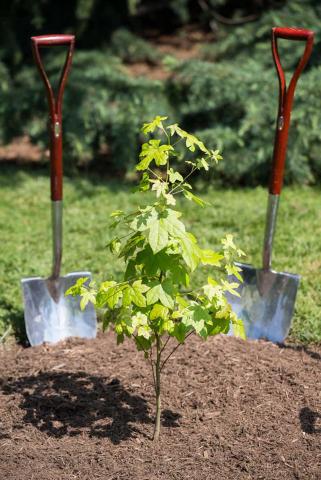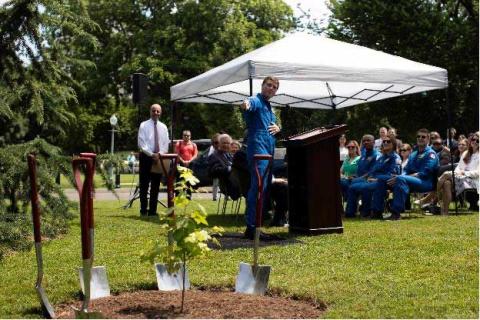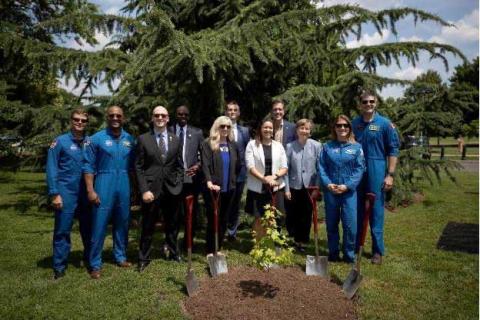
Introducing the NASA Artifact Program and the Artemis I Moon Tree Project
Space, Science & Technology, Innovation at LMI, CivilianThe Artifact Program, jointly managed by NASA’s Logistics Management Division (LMD) and the Office of Communications, plays a vital role in preserving and sharing NASA's rich history. This program, supported by LMI’s Wayne Cragwell and Christopher Ainsworth, facilitates the transfer of artifacts to educational and nonprofit organizations, engaging the public with NASA's legacy. One of the most exciting recent initiatives of the Artifact Program is its involvement in the Artemis I Moon Tree Project.

Photo is NASA owned and allowable per use guideline here.
The Artemis I Moon Tree Project: A Historical Endeavor
During the Artemis I mission, NASA sent 2,000 seeds from various tree species around the far side of the moon, marking the furthest any living organism has traveled from Earth and returned. This historic mission was part of NASA’s broader Artemis program, which aims to return humans to the moon and, eventually, reach Mars.
Upon the seeds’ return, NASA partnered with the United States Department of Agriculture (USDA) Forest Service to germinate the seeds and nurture them in nurseries across the United States. By fall 2023, NASA’s Office of Science, Technology, Engineering, and Mathematics Engagement (OSTEM); USDA Forest Service; and LMD joined forces to review requests and growth plans from organizations eager to host a moon tree.
Selection and Distribution Process
NASA’s Artifact Program, exercising its authority under the Stevenson–Wydler Act, facilitated the transfer of these seeds to eligible organizations. Artifact Program facilitators Wayne Cragwell and Christopher Ainsworth meticulously vetted nearly 2,000 applicants, ensuring the eligibility of each selected organization to receive a moon tree under the agency’s transfer authorities. Meanwhile, the USDA Forest Service and OSTEM evaluated the proposed growth plans and planting sites for conformance with the requirements.
By combining these rigorous reviews, OSTEM, the USDA Forest Service, and LMD selected the organizations best suited to care for a moon tree. The distribution of these trees is occurring in phases, alternating between spring and fall seasons in 2024 and 2025.
First Round of Moon Tree Distributions
The initial distribution began in March 2024 and Goddard Space Flight Center was crucial in transferring the trees to nearly 150 organizations. The first recipient, the U.S. Capitol, received a sweetgum tree—an impressive species that can grow up to 70 feet tall with a trunk diameter of up to 40 inches.
Representative Hal Rogers of Kentucky hosted the U.S. Capitol Moon Tree Planting Ceremony, which NASA Deputy Administrator Pam Melroy and Artemis II astronauts Reid Wiseman, Christina Koch, Victor Glover, and Jeremy Hansen attended. The ceremony marked a significant milestone, celebrating the collaboration between NASA and various partners to bring a piece of space exploration history to the heart of the nation's capital.

Photo Courtesy Architect of the Capitol

Photo Courtesy Architect of the Capitol
Other moon tree recipients include educational institutions, museums, and community organizations nationwide. Each organization was chosen based on its ability to care for the trees and use them as educational tools to engage the public in the story of space exploration and environmental stewardship.
Looking Ahead
The next round of moon tree distributions is scheduled for fall 2024 and will continue through 2025. This ongoing initiative underscores the critical support provided by LMI’s support to LMD in collaboration with OSTEM and the USDA Forest Service. Together, they ensure the successful placement of these living pieces of lunar history in environments where they can thrive and inspire future generations. Through the Artemis I Moon Tree Project, the NASA Artifact Program continues to preserve NASA's legacy while planting the seeds for future exploration and discovery.
About LMI’s Role
LMI’s involvement in the NASA Artifact Program highlights our commitment to fostering innovation and supporting federal initiatives that engage and educate the public. Wayne Cragwell and Christopher Ainsworth exemplify LMI’s dedication to excellence in their meticulous work with the Artifact Program, ensuring the successful distribution and placement of moon trees nationwide. Their efforts are instrumental in connecting NASA’s storied past with future generations through tangible, living artifacts.


